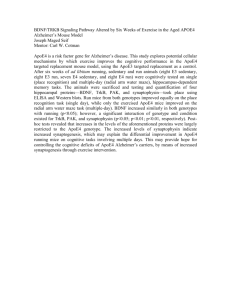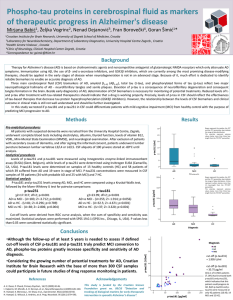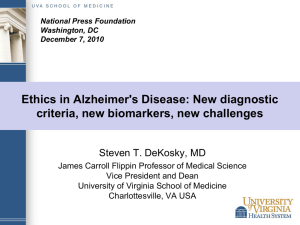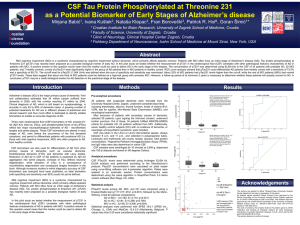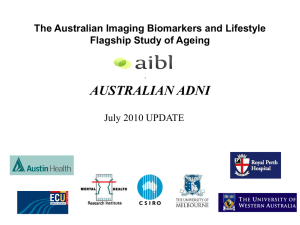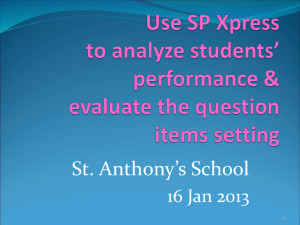presentation
advertisement
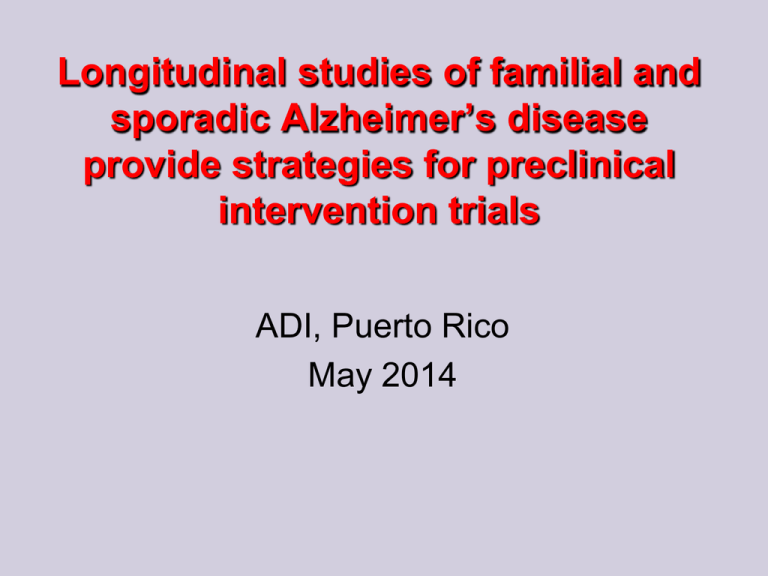
Longitudinal studies of familial and sporadic Alzheimer’s disease provide strategies for preclinical intervention trials ADI, Puerto Rico May 2014 The Incidence of Alzheimer’s Disease 100 90 80 70 Crude Annual Incidence per 1,000 X 60 50 40 30 X 20 X 10 X X 0 0-39 40-49 50-59 60-69 X X X 70-79 80-89 90+ Age Framingham (Bachman et al, 1993) Chicago (Evans et al, 2003) East Boston (Hebert et al, 1995) X Baltimore (Kawas et al, 2000) All The Amyloid Cascade Hypothesis b Ab monomers g Ab Aggregation a g APP Amyloidgenic Pathway P3 Amyloid plaque Nonamyloidgenic Pathway Inflammation Neuronal loss and AD Ab, b-amyloid; AD, Alzheimer’s disease; APP, amyloid precursor protein Tau pathology Aβ PRODUCTION APP BACE1 C99 γ-sec Aβ40, 42 dimer Integral membrane, (α–helix) ⇌ Aβ – Aβ INTERACTIONS Membrane associated (Oligomeric intermediates) Aβ toxic oligomer Membrane associated and/or diffusible ApoE Aβ40, 42 oligomer 2° nucleation dependent on [fibril] Fibrillar amyloid deposits Membrane free diffusible, (β–turn) Aβ40, 42 oligomer 1° nucleation (Zn++/Cu++) dependent on [monomer/oligomer] Extracellular, (β–sheet) Aβ CLEARANCE ApoE, Clu, ABCA7, CD33, TYROBP, etc (phagocytosis pathway) Aβ Metabolic Pools (CSF reflecting brain ISF) sAD (Mawuenyega, Bateman et al 2010) •Production rate Aβ42 is equal to controls •Clearance rate of Aβ42 is 49% slower in AD •It takes 13 hours for the complete turnover of the CSF pool for controls and 19 hours for sAD. There is a 42% impairment in the production:clearance ratio in sAD •Protective effect of A673T substitution in APP adjacent to BACE1 cleavage site results in 40% reduction in Aβ in vitro production (Jonsson et al., 2012) ADAD (Potter, Bateman et al., 2013 •Production rate of Aβ42 is increased 18%. No change Aβ38,40 •Soluble Aβ42:40 fractional turnover rate is increased 65%, consistent with the increased removal of Aβ42 through extracellular deposition •Newly formed Aβ is in exchange equilibrium with pre-existing Aβ, possibly in oligomers or other aggregates, possibly by 20 nucleation events derived from existing fibrillar aggregates What Is the Best Target for a Disease-Modifying Drug (DMD)? • • • • • • • g-secretase inhibitor? b-secretase inhibitor? Ab oligomer? Aggregated fibrillar Ab? Ab clearance mechanism? APP/Ab processing? ….or a combination of any above? P3 oligomer model based on crystal structure Streltsov, Nuttall 2011 The Australian Imaging, Biomarkers and Lifestyle Study of Aging Australian ADNI AIBL: Longitudinal cohort: Baseline to 54 months. Baseline (1,112) 372 NMC Non-return: 112 Deceased: NMC 2 SMC 4 MCI 5 AD 17 Non-AD dementia: PDD 1 36 month (824)* 54 month¤ (676)* Returned at 36 months: NMC 11 SMC 1 MCI 1 AD 3 Non-return: 74 Deceased: NMC 2 SMC 1 MCI 1 AD 27 VDM 1 Non-AD dementia: MCI-X 2 VDM 2 Returned at 54 months: NMC 1 SMC 4 MCI 1 AD 1 211 AD (29) (50) ApoE4 carrier ApoE4 carrier ApoE4 carrier ApoE4 carrier 107 (28.8%) 97 (24.5%) 66 (49.6%) 132 (62.6%) (97) (114) 317 NMC Non-return: 120 Deceased: NMC 3 SMC 3 MCI 4 AD 34 Non-AD dementia: PDD 1 MCI-X 1 VDM 3 133 MCI (29) (33) (220) 18 month (972)* 396 SMC (254) (7) (4) (13) (65) 375 SMC (3) (32) (161) 82 MCI (41) (39) (1) 197 AD (62) (26) ApoE4 carrier ApoE4 carrier ApoE4 carrier ApoE4 carrier 90 (28.4%) 94 (25.1%) 32 (39.0%) 136 (69.0%) (212) (78) (62) (241) 301 NMC (5) (4) (35) (14) 309 SMC (20) (14) (1) (1) 55 MCI (10) (16) (134) 154 AD (62) ApoE4 carrier ApoE4 carrier ApoE4 carrier ApoE4 carrier 82 (27.2%) 80 (25.8%) 24 (43.6%) 106 (68.8%) (202) (50) (2) (72) (207) (7) (4) (19) (27) 51 MCI (1) (6) (68) 255 NMC 290 SMC 76 AD ApoE4 carrier ApoE4 carrier ApoE4 carrier ApoE4 carrier 64 (25.1%) 74 (25.5%) 19 (37.3%) 52 (68.4%) Methodology: Key outcomes CLINICAL/COGNITIVE Clinical and cognitive measures • MMSE, CDR, Mood measures, Neuropsychological battery Clinical classification information • NINCDS-ADRDA (possible/probable) AD classifications • ICD-10 AD classifications • MCI classifications • Memory complaint status (in HC) LIFESTYLE Lifestyle information Detailed dietary information Detailed exercise information Objective activity measures (actigraph – 100 volunteers) Body composition scans (DEXA) Medical History, Medications and demography BIOMARKERS NEUROIMAGING Comprehensive clinical blood pathology Neuroimaging scans (in 287 volunteers) Genotype • Apolipoprotein E, WGA in subgroup PET Pittsburgh Compound B (PiB) Stored fractions (stored in LN within 2.5 hrs of collection) • Serum • Plasma • Platelets • red blood cell, • white blood cell (in dH20) • white blood cell (in RNAlater, Ambion). Magnetic Resonance Imaging • 3D T1 MPRAGE •T2 turbospin echo •FLAIR sequence 11 11C-PIB HC for Ab imaging AD SUVR 3.0 1.5 0.0 Villemagne / Rowe Ab burden quantification NEOCORTICAL SUVR40-70 3.50 *† * * † HC MCI AD DLB FTD (n = 117) 30% pos (n = 79) 64% pos (n = 68) (n = 14) (n = 21) 3.00 2.50 2.00 1.50 1.00 (n = 299) Villemagne and Rowe 13 Longitudinal PiB PET follow-up HC Progression to aMCI Progression to naMCI Progression to AD (n=104) 3.5 3.3 Neocortical SUVR 3.0 2.8 2.5 2.3 2.0 1.8 1.5 1.3 1.0 55 60 65 70 75 80 85 90 95 Age (years) * PiB+/PiB- SUVR cut-off = 1.5 Villemagne / Rowe Longitudinal PiB PET follow-up MCI Progression to FTD Progression to VaD Progression to AD (n=48) 3.5 3.3 Neocortical SUVR 3.0 2.8 2.5 2.3 2.0 1.8 1.5 1.3 1.0 55 60 65 70 75 80 85 90 95 Age (years) * PiB+/PiB- SUVR cut-off = 1.5 Villemagne / Rowe Longitudinal PiB PET follow-up AD (n=33) 3.5 3.3 Neocortical SUVR 3.0 2.8 2.5 2.3 2.0 1.8 1.5 1.3 1.0 55 60 65 70 75 80 85 90 95 Age (years) * PiB+/PiB- SUVR cut-off = 1.5 Villemagne / Rowe AIBL: Aβ deposition over time MCI+ 3.0 Neocortical SUVRcb AD HC+ 2.5 Mean SUVR AD+ (2.33) 2.9%/yr 2.0 (95%CI 2.5-3.3%/yr) 1.5 19.2 yr (95%CI 17-23 yrs) Mean SUVR HC(1.17) 12.0 yr HC- MCI- (95%CI 10-15 yrs) 1.0 0 10 20 Time (years) 30 40 AIBL: Relationship between “abnormality” and CDR of 1.0 Plasma Ab Levels Compared With CSF Ab Levels Plasma (pg/mL) HC (n = 576) MCI (n = 69) AD (n = 125) ↑/↓ in MCI or AD Ab1-40 157.7 ± 31 166.8 ± 37 172.3 ± 41 ↑ Ab1-42 34.8 ± 10 33.6 ± 11 34.5 ± 10 ↓ 0.22 ± 0.06 0.20 ± 0.05* 0.20 ± 0.04* ↓ Ab1-42/Ab1-40 CSF (pg/mL) HC (n = 24) MCI (n = 62) AD (n = 68) ↑/↓ in MCI or AD Ab1-40 9600 ± 3000 9500 ± 3200 8500 ± 2800* ↓ Ab1-42 403 ± 125 307 ± 114)* 263 ± 83* ↓ tau 104 ± 59 155 ± 109* 156 ± 87* ↑ p-tau-181 31 ± 17 42 ± 29 43 ± 26* ↑ *P < 0.05 vs HC. Data are represented as mean ± standard deviation. Kester MI, et al. Neurobiol Aging. 2012;33:1591-1598; Rembach A, et al. Alzheimers Dement. In press. Model: metal-chaperones with moderate affinity for metals (nanomolar 10-9) (low picomolar 10-11) Xilinas, Barnham, Bush, Curtain Prana Biotechnology, founded 1998 (Geoffrey Kempler) PBT2: SAR based on rational drug design Follow Ups CQ(PBT1) ‘POC’ Clinical trials 180+ screened Strong SAR Multiple scaffolds 130+ screened PBT2 non 8-OHq activity Tox testing POC PBT3 – PBT-x Phase Ia & Ib Phase IIa > 45 in vivo candidates Tox. testing Barnham, Kripner, Kok, Gautier (Prana Biotechnology), 2002 Analysis of CQ / PBT2 interactions with Aß Monomer Analytical Ultracentrifugation Small oligomers Large oligomers CQ and PBT2 induce the formation of low molecular weight Aß oligomers (consistent with dimers/trimers) Tim Ryan, Blaine Roberts Effect of PBT2 and placebo on the change in biomarkers from baseline at 12 weeks (A) CSF Aβ42, (B) CSF Aβ40, (C) CSF T-tau, and (D) CSF P-tau. Data are least mean squares (SE). Scatter plots of individual actual changes from baseline at 12 weeks for CSF Aβ42 and Aβ40 are shown, with mean values (horizontal bars) included for each treatment group. 13% fall in CSF Aβ42 Lannfelt et al., Lancet Neurology (2008) Protein misfolding diseases: strategy for disease modification Stabilize! Neutralize! Clear! 24 DIAN and A4: early intervention in preclinical AD DIAN-TU • • • • • Autosomal Dominant AD – genetic mutation causing early onset dementia across generations of the same family 50% risk of inheriting gene from mutation +ve parent If mutation +ve penetrance of ADAD is nearly 100% DIAN observational trial has been following ADAD families since 2009, giving valuable insight into changes that occur decades before symptoms appear PRIMARY AIM: to determine whether Solanezumab or Gantenerumab can prevent, delay or possibly even reverse AD changes in the brain Monthly infusion/injection for 2 years Measures include: MRI, PET scans (PiB, FDG, AV-45), CSF and blood biomarkers, cognitive function STARTING TREATMENT BEFORE SYMPTOMS APPEAR MAY GIVE BETTER OUTCOME Anti-Amyloid Treatment in Asymptomatic Alzheimer’s disease (the A4 Study) The Melbourne Composite Site Key Objectives • Cognitive: – To test the hypothesis that in preclinical AD, an anti-amyloid therapy (solanezumab) will slow Aβ-associated cognitive decline as compared with placebo. • Neuroimaging: – To test the hypothesis that solanezumab reduces Aβ amyloid burden, as compared with placebo, as assessed using florbetapir PET imaging ligand. – To determine if there are downstream effects of solanezumab on brain tau using the novel tau PET imaging ligand, T807. • Biomarkers: – To assess effects of solanezumab on CSF concentrations of Aβ, p-tau and tau. – To explore the role of polymorphisms in apolipoprotein E (ε carrier [ε4+], ε4 non-carrier [ε4-] and brain derived neurotrophic factor (BDNFVal/Val, BDNFMet) and other genetic loci in the extent to which they moderate the rate of Aβrelated memory decline in both treated and placebo groups. Key inclusion criteria – 65-85 years – Evidence of Aβ amyloid (PET) – Asymptomatic (Clinical dementia rating = 0) Key points: Protocol • Following screening, 4 weekly solanezumab/placebo (1:1) infusions (IV) for 168 weeks • Cognitive testing @ baseline then 12/52 from week 6 • Aβ amyloid and tau (PET) @ baseline, years 1, 2, 3. • Aβ amyloid and tau (CSF) @ baseline and year 3. • Blood for biomarkers (AIBL protocol)@ baseline, weeks 12, 24, 48, 108 and 168? The AIBL Study Team Osca Acosta David Ames Jennifer Ames Manoj Agarwal David Baxendale Kiara Bechta-Metti Carlita Bevage Lindsay Bevege Pierrick Bourgeat Belinda Brown Ashley Bush Tiffany Cowie Kathleen Crowley Andrew Currie David Darby Daniela De Fazio Denise El- Sheikh Kathryn Ellis Kerryn Dickinson Noel Faux Jonathan Foster Jurgen Fripp Christopher Fowler Veer Gupta Gareth Jones Jane Khoo Asawari Killedar Neil Killeen Tae Wan Kim Eleftheria Kotsopoulos Gobhathai Kunarak Rebecca Lachovitski Nat Lenzo Qiao-Xin Li Xiao Liang Kathleen Lucas James Lui Georgia Martins Ralph Martins Paul Maruff Colin Masters Andrew Milner Claire Montague Lynette Moore Audrey Muir Christopher O’Halloran Graeme O'Keefe Anita Panayiotou Athena Paton Jacqui Paton Jeremiah Peiffer Svetlana Pejoska Kelly Pertile Kerryn Pike Lorien Porter Roger Price Parnesh Raniga Alan Rembach Miroslava Rimajova Elizabeth Ronsisvalle Rebecca Rumble Mark Rodrigues Christopher Rowe Olivier Salvado Jack Sach Greg Savage Cassandra Szoeke Kevin Taddei Tania Taddei Brett Trounson Marinos Tsikkos Victor Villemagne Stacey Walker Vanessa Ward Michael Woodward Olga Yastrubetskaya Neurodegeneration Research Group The University of Melbourne • • • • • • • • • • • • • • • • Paul Adlard Kevin Barnham Shayne Bellingham Martin Boland Ashley Bush Roberto Cappai Michael Cater Robert Cherny Joe Ciccotosto Steven Collins Peter Crouch Cyril Curtain Simon Drew James Duce Genevieve Evin Noel Faux The Mental Health Research Institute • • • • • • • • • • • • • • Michelle Fodero-Tavoletti David Finkelstein Catherine Haigh Andrew Hill Ya Hui Hung Vijaya Kenche Vicky Lawson Qiao-Xin Li Gawain McColl Chi Pham Blaine Roberts Laura Vella Victor Villemagne Tony White Collaborators • Alfred Hospital: Catriona McLean • Austin Health: Chris Rowe, Victor Villemagne • Chemistry (Uni Melb): Paul Donnelly • Cogstate: Paul Maruff • CSIRO (Structural Biology): Jose Varghese, Victor Streltsov, Stewart Nuttall • Imperial College London: Craig Ritchie • Mass General Hospital / Harvard Med School: Rudy Tanzi • NARI: David Ames, Kathryn Ellis • SVIMR: Michael Parker, Luke Miles • Network Aging Research (Heidelberg): Konrad Beyreuther
